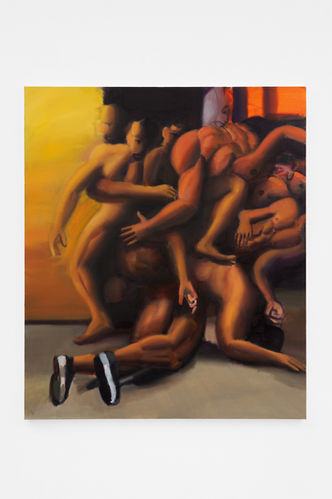Murat Oenen
“Haystacks”
April 21 - June 4, 2022
Murat Oenen’s “Haystacks” depict heaps and piles and stacks of men. It’s repetitive, just as Monet’s “Haystacks” were. The purpose of this repetition, similar to Monet’s, is about seeking. For the Impressionist it was about seeking out change in light according to time of day or season - it was about the impression of the same thing changing according to the “when” of it all. For Oenen, the seeking is about breaking from academic formality in painting, from his own oeuvre, from his own identity, and from tropes of masculinity itself; this seeking is about painterly intuition, about the struggle to break from identity - be it queerness, or masculinity - itself.
Influences abound. Not just Monet, as referenced in the namesake of the exhibition, but also Guston and Bacon in the stylized violence and humor of the works; and Delacroix and Tinteretto in the light and movement, the upheaval of bodies. Oenen carves out his place in the canon, and then intuitively and adeptly paves a singular path.
This series represents a new formal direction for the artist. A lot has happened in the world since his first solo with us in the Summer of 2020. That exhibition, a small vitrine show, (viewable only from the street in order to adhere to Covid-19 rules), was, while consisting of just two small paintings, emblematic of the start of a formal and meaningful shift in his practice.
His earlier works were largely steeped in Edward Hopper-esque late-night loneliness, melancholy - in his case in the context of Queer club scenes. Or, they focused on muscle-men or sexual sub-cultures. But, his work, starting with those from 2020, began to look less at states of being Queer and more at creation, or the apotheosis - the performance of gender and queerness, or even more particularly and specifically the performance of masculinity.
There was once a more clear thread linking the artist’s own life to his paintings. He was a painter studying in the academy, moonlighting as a DJ at Queer parties. He was painting in an academic tradition. He was painting what he knew, what he saw. These paintings in “Haystacks” are no longer a reflection of the artist’s identity or lifestyle, his gaze. They are process paintings, done intuitively as a way to look for the many possible iterations of this dynamic composition of men; they are wild and fabricated. They are the exact embodiment of what they represent - the messiness of masculinity, the struggle of queerness.
The paintings are more abstract than his previous works, more fluid. Bodies blend and mesh with each other, sometimes brushstrokes are definitive and sometimes they are not. Oenen paints a blue to suggest a sky, a beige to suggest a floor, an orange or yellow to suggest some light. But, mostly, these paintings lack spatiality. The composition is not dependent on anything besides the bodies. The bodies - these woven, chaotic men - piled and stacked and heaped, are saying as much about figurative painting today as they are saying about performative masculinity. There is a crisis, it is felt; and, like Oenen, like these works, in process and context, we don’t know where it’s going, we have no ground - just heaps and piles and stacks of complexities in the throes of change.
- Nicole O’Rourke












